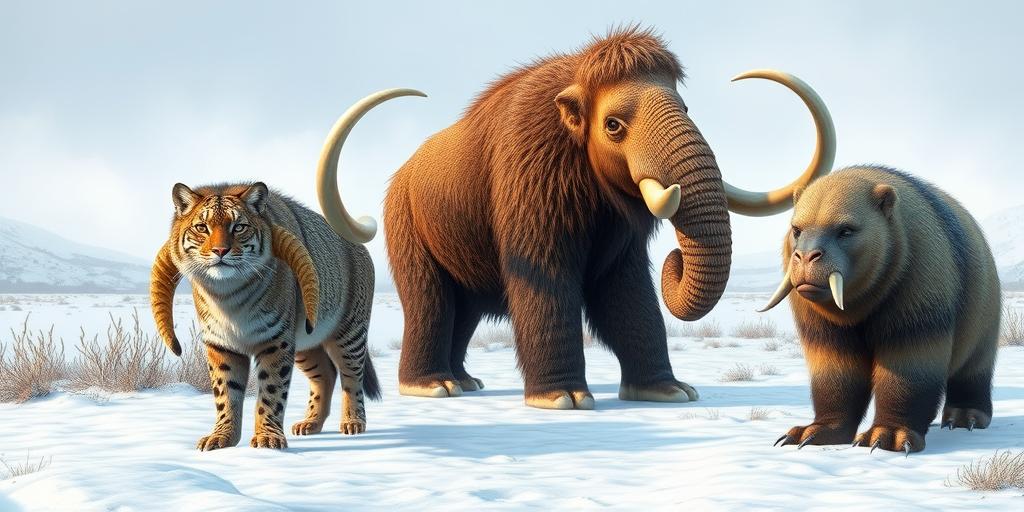Ice Age Creatures: Giants of the Pleistocene
The Pleistocene Epoch, often referred to as the Ice Age, spanned from approximately 2.6 million to 11,700 years ago. This period was characterized by significant climate fluctuations, with multiple glacial advances and retreats shaping the landscape and influencing the evolution of life. Among the most captivating aspects of this era were the megafauna – the large and often imposing creatures that roamed the Earth. This post explores some of the most iconic giants of the Pleistocene, shedding light on their characteristics, habitats, and eventual extinction.
The Woolly Mammoth
The Woolly Mammoth (Mammuthus primigenius) is perhaps the most well-known of the Ice Age creatures. Adapted to the cold, harsh environments of the northern hemisphere, these mammoths possessed thick fur, a layer of subcutaneous fat, and small ears to minimize heat loss. Their curved tusks could grow up to 15 feet long and were used for foraging, defense, and display. Woolly Mammoths primarily grazed on grasses and sedges in the mammoth steppe, a vast, open landscape that stretched across Europe, Asia, and North America.
The Saber-Toothed Cat
The Saber-Toothed Cat, particularly Smilodon fatalis, was a formidable predator of the Pleistocene. Characterized by its elongated canine teeth, which could reach up to 11 inches in length, this feline was well-equipped for hunting large herbivores. Smilodon was powerfully built, with strong forelimbs for grappling prey. It likely ambushed its victims, using its saber-like teeth to deliver a fatal bite to the throat. Fossils of Saber-Toothed Cats have been found in North and South America, indicating their widespread presence across the continents.
The Giant Ground Sloth
Several species of Giant Ground Sloths existed during the Pleistocene, with Megatherium americanum being one of the largest. These massive herbivores could reach up to 20 feet in length and weigh several tons. Unlike their smaller, tree-dwelling relatives today, Giant Ground Sloths were terrestrial and possessed robust limbs and strong claws. They fed on a variety of plants, including leaves, branches, and fruits. Fossil evidence suggests that Giant Ground Sloths inhabited diverse environments, from forests to grasslands, across North and South America.
The Woolly Rhinoceros
The Woolly Rhinoceros (Coelodonta antiquitatis) was another iconic creature adapted to the cold climates of the Ice Age. Similar in appearance to modern rhinoceroses, the Woolly Rhino possessed a thick coat of fur and two horns – a large one on its nose and a smaller one between its eyes. These rhinos were well-suited to grazing on the grasses and shrubs of the mammoth steppe. Fossils of Woolly Rhinoceroses have been found throughout Europe and Asia, often in association with Woolly Mammoth remains.
The Irish Elk
The Irish Elk (Megaloceros giganteus) was the largest deer that ever lived. Despite its name, the Irish Elk was not exclusive to Ireland and roamed across Europe and Asia. The most striking feature of this deer was its enormous antlers, which could span up to 12 feet in width. These antlers were likely used for display during mating season. The Irish Elk inhabited open woodlands and grasslands and primarily fed on grasses and herbaceous plants.
Extinction
The end of the Pleistocene marked a period of significant environmental change, with the retreat of glaciers and shifts in vegetation. These changes, coupled with the increasing presence of humans, led to the extinction of many megafaunal species. While the exact causes of these extinctions are still debated, a combination of climate change and human hunting is likely responsible for the demise of these magnificent creatures. The loss of the Ice Age giants represents a significant chapter in the history of life on Earth, reminding us of the vulnerability of even the largest and most well-adapted species.
Conclusion
The Ice Age was a time of remarkable creatures, each uniquely adapted to the challenges of a cold and fluctuating climate. From the Woolly Mammoth to the Saber-Toothed Cat, these giants of the Pleistocene capture our imagination and provide valuable insights into the Earth's past. Studying these extinct animals helps us understand the processes of evolution, adaptation, and extinction, offering lessons that are relevant to the conservation of biodiversity today.









